Saratobogganing: The Spa’s Steepest Slopes
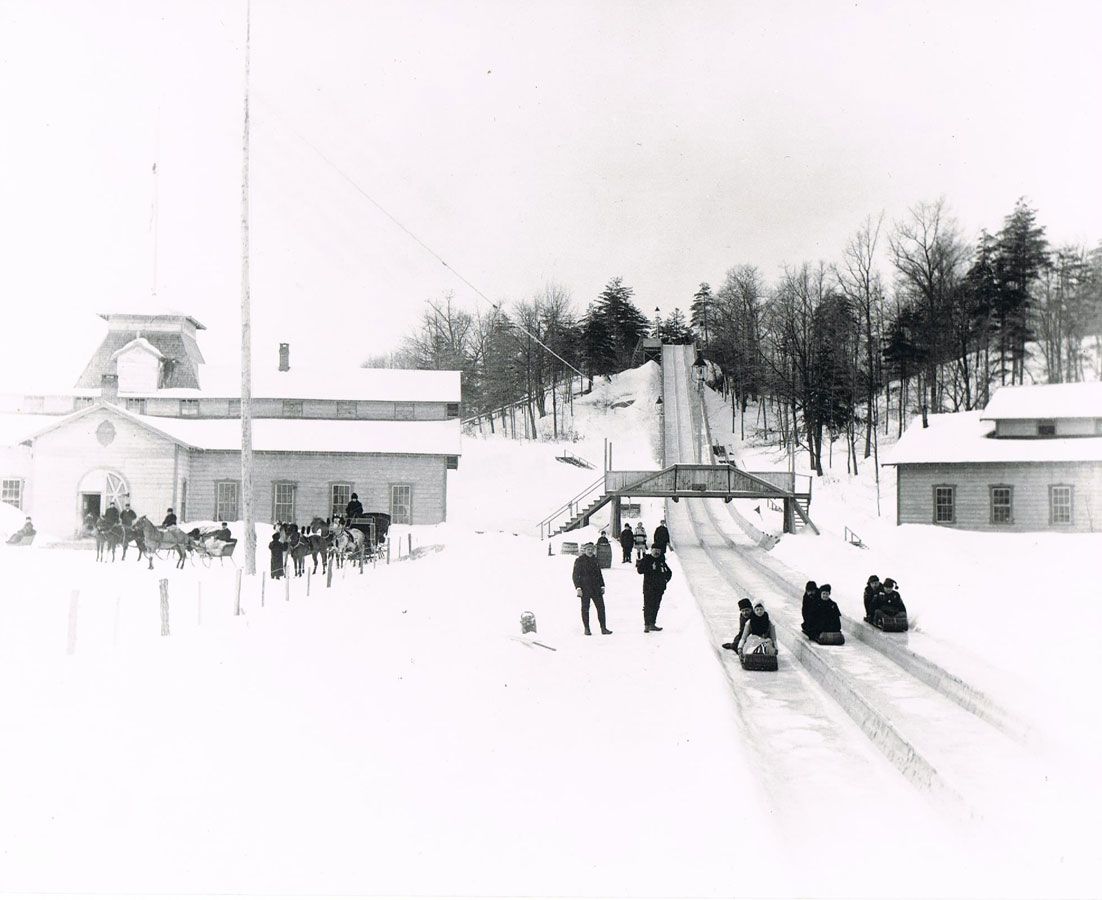
{From the 2023 Holiday Magazine}
Written by Bill Orzell
The Gilded Age witnessed Saratoga Springs’ development into a key resort destination.
The healing mineral waters and the rousing contests between the best Thoroughbred horses, along with the lure of fortune at faro and roulette tables, established the idyllic village as the summer place to be. Yet when the days shortened to autumn, and shortened still into a white winter, alternate recreation was required.
Several of the village’s young adults, men and women who enjoyed socializing as a group, ventured north to Montreal for winter carnivals. Along the slopes of Mount Royal they experienced the thrill and awesome speed of a toboggan slide. Returning back to the Spa in winter, they decided as a group to build and operate their own frigid season diversion, and collectively reformed snow and ice into exciting days and nights coasting at high speed.
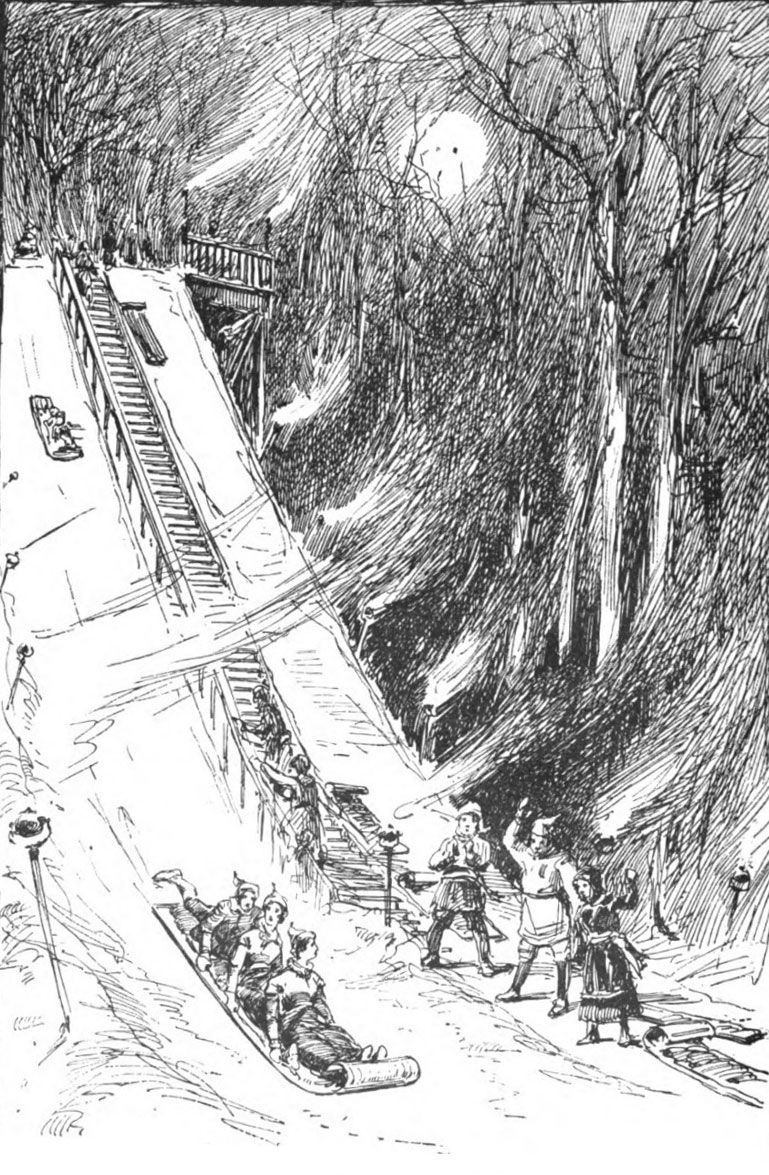
Moonlight on the toboggan slide at Woodlawn Park, described as “a mile-a-minute pace” from Saratoga: Winter and Summer by Prentiss Ingraham 1885. Famous novelist Prentiss Ingraham is listed on the charter member roster of the Woodlawn Park Toboggan Club.
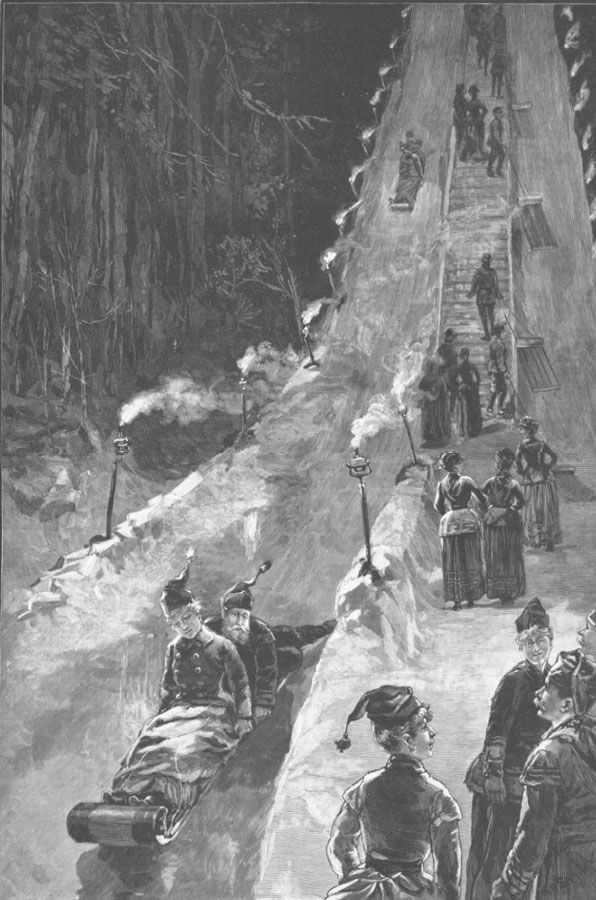
Tobogganing at Saratoga, illustration by Willard Poinsette Snyder and published in Harper’s Weekly magazine February 7, 1885. Any guesses as to the identity of the couple on the toboggan
The toboggan, or sled without runners, were created from local beech and birch trees, with the wood steamed until a leading edge dash curl could be formed and the strips joined in the manner of barrel staves. The geography of Saratoga Springs provided many downhill runs, and the force of gravity was amplified by a summit structure, also of wood construction. A framework tower of about fifty feet formed the point of departure, with chutes which had been paved with ice blocks extended downslope on a trestle-work incline of twenty-three degrees, otherwise a grade of four-to-one where the slide which provided the toboggan the initial impetus meeting the natural declivity for a whizzing flight of fun.
The first toboggan slide was erected at Woodlawn Park, near the present location of Skidmore College, perhaps in the early 1880s. This initial structure had two chutes, divided by a center stairway, and equipped with lantern stanchions for nighttime tobogganing. After a schuss down the first chute and hill, returning coasters would drag their toboggans up the second chute as they climbed the stairs, providing healthful outdoor exercise. The slides were groomed by the assiduous application of water for the highest attainable degree of lubricity, yielding a reduction in friction to nearly null and allowing toboggans to travel at the rate of fifty feet per second. These speeds were perhaps the fastest people of this era ever traveled. The frigid air was full of merry laughter combined with shouts of joyous glee from those upon upholstered seats who scooted along with a clutching grip on their toboggan’s grab-rails until they reached the haystack barrier at the end. If the coasters were not yet satisfied by speed and the rushing wind it created, they could return to the slide for another run; otherwise it was pleasant to warm up around the assembly parlor’s hot stove in the Clubhouse and partake of refreshments while gazing through frosted window panes at others enjoying the slide.
The 1884 incorporation of the Woodlawn Park Toboggan Club is an indication of the swift increase in the popularity of this wintry recreation, which soon found a need to expand their facility. Harper’s Weekly magazine in their February 7, 1885 issue wrote, “A local club has projected and completed one of the toboggan slides which elevate the simple pastime of sliding down hill into a sport.” In March of 1885 the Saratogian announced the Club, who they credited with “organizing the initial slide in the United States,” had leased from Lemuel B. Pike and John McBain Davidson the 47 acre Glen Mitchell driving park and gun club property, and planned to erect a larger three-chute toboggan slide there in time for the next winter. The following month the Club would revise its corporate identity to the Saratoga Toboggan Club and begin construction of their new facilities a short distance north of their original slide, which would include a bridge or grade separated crossing, over the three chutes for safety and observation purposes and direct access to the improved Clubhouse. The Club roster was published, listing many prominent local citizens such as Edgar T. Brackett, Louis H. Cramer, Harry Levengston, the Lester Brothers, Spencer Trask, and many others. Another development allowed by the increased space at Glen Mitchell was that the snowbanks flanking both sides of the track beyond the slide were built up higher, groomed and iced for added speed, while also preventing the toboggans from straying into the shadowed pines and leafless trees. The 2,650 feet of the frost-filled fun run at Glen Mitchell was generally accomplished in 19 seconds.
The Worden House was long known as a year-around hostelry in Saratoga, and Mr. Worden extended his café business to the Clubhouse at Glen Mitchell where the buffet tables reputedly groaned from the weight of the spread. When snow did not arrive as expected, a water wagon would sprinkle the route from the Worden House to Glen Mitchell in the evening, paving the path with ice to allow well robed horse drawn sleighs to transport tobogganers back and forth. The long cold winter nights were made cheerful by the glittering lights at the Toboggan Club, provided by torches and lanterns and reflected on the snow and ice, and further enhanced by the moon in its various phases and cloud filters and the boundless display of stars.
In 1886 Jim Riley, one time champion oarsman on Saratoga Lake, built Riley’s Lake House, a famous operation for generations that included all-season waterfront amusements which incorporated a toboggan slide. The thrill of “shooting the chute” through the years was perpetuated at the other famous Saratoga Lake Houses; Newman’s and the Arrowhead.
As with many other social activities at the Spa, fashion played a role, and handsome merino and fleece toggery were worn by both men and women over long flannel underwear. Toques, a close-fitting knit hat, and stocking caps which extended into a tassel or pom-pom were very popular, as were satin hoods. Insulated boots, with protective toe caps, shielded the wearer from the hard slippery surface and cold. Toboggans were decorated with distinctive paint and padded cushions, identifying a family or group, often with the blankets, clothing and hats in matching hues.
Winter Carnivals were staged in Congress Park following the end of the First World War, and Saratogians harkened back to their Victorian predecessors and erected a toboggan slide which ran from the high-ground near Circular Street, past the Casino, toward Spring Street.
On July 3, 1885 the New York Times reported on the preparations for Independence Day at Saratoga Springs, which included visits by two of the nineteenth century’s most famous authors, Harriet Beecher Stowe and Mark Twain, who came to the Spa to visit former President Grant at Mount McGregor. In this same article the Times reporter, reminiscing about the previous winter wrote, “one effect of the Winter gayeties last January is seen in the coining of a new word, “Saratobogganing.”’ In our time, the Saratoga Springs History Museum in the marvelous Canfield Casino has a fine display with an actual nineteenth century toboggan and a period sculpture which conveys the joie de vivre of those halcyon winter days.
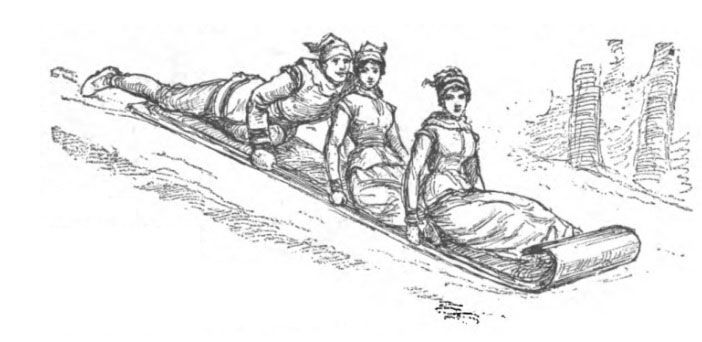
Toboggan Club members enjoying the slide from Saratoga: Winter and Summer by Prentiss Ingraham 1885.
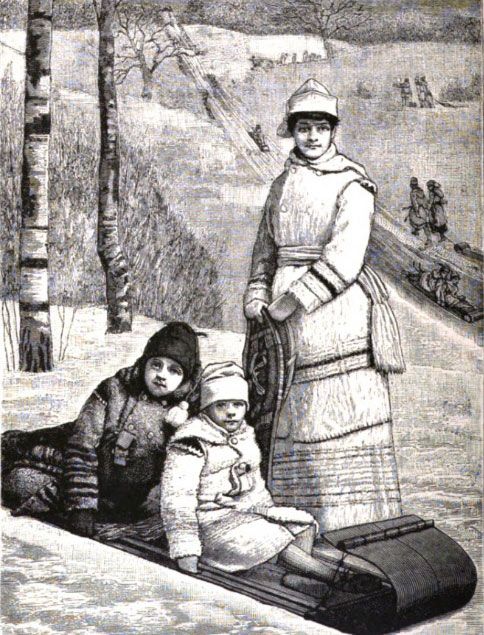
Young tobogganers depicted at Saratoga in Frank Leslie’s Budget magazine February 1893.
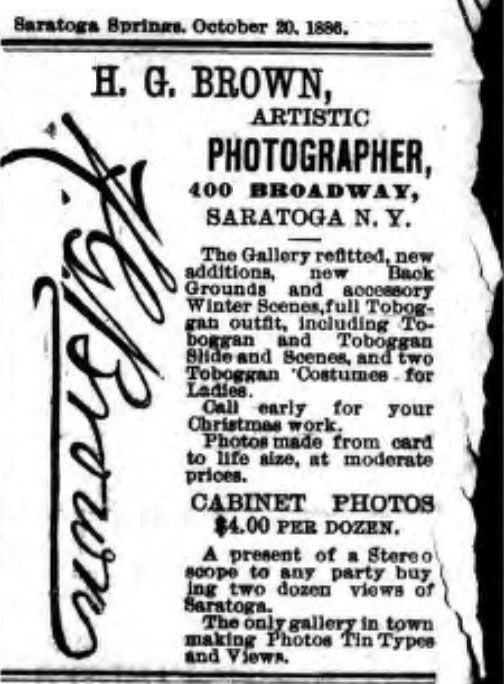
Advertisement in the 1886 Saratogian, catering to the toboggan trade.
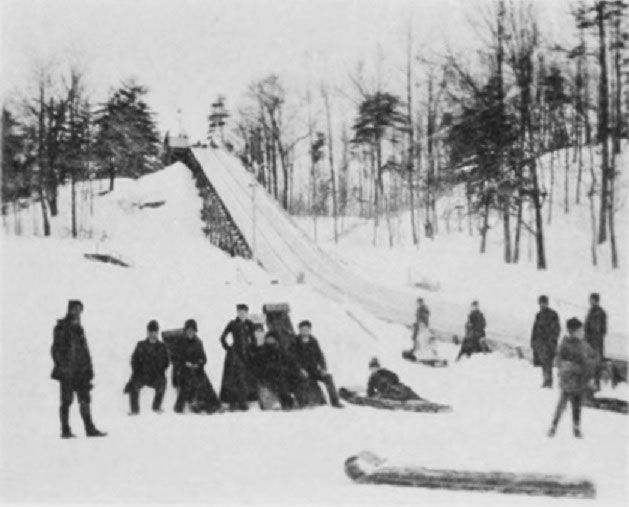
Toboggan slide thought to be at Riley’s Lake House from Saratoga Springs: Camera Slivers From the Famous Spa by Chas. H. Possons 1887.
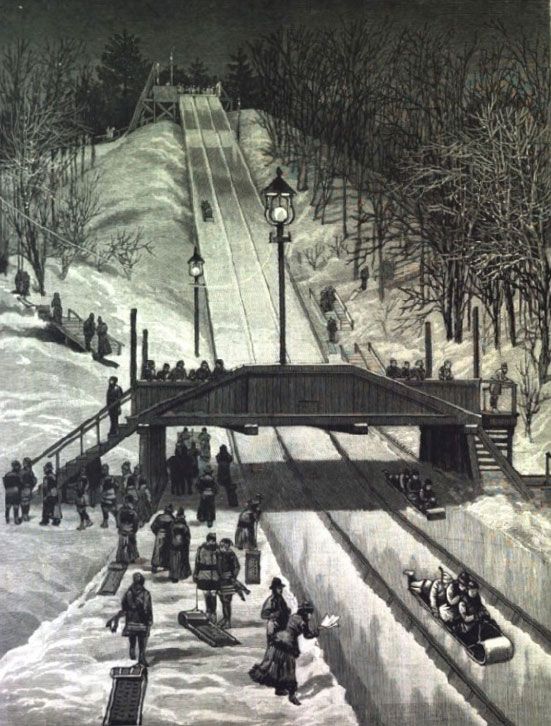
Glen Mitchell three chute toboggan slide and grade separated crossing from Frank Leslie’s Illustrated Newspaper January 29, 1887.
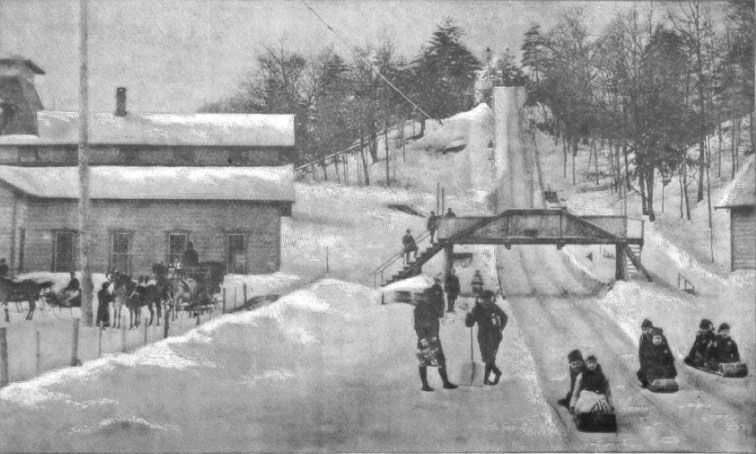
Saratobogganing the three chute slide at Glen Mitchell and nearby Clubhouse of the Saratoga Toboggan Club from Saratoga Chips and Carlsbad Wafers by Nathan Sheppard 1887.